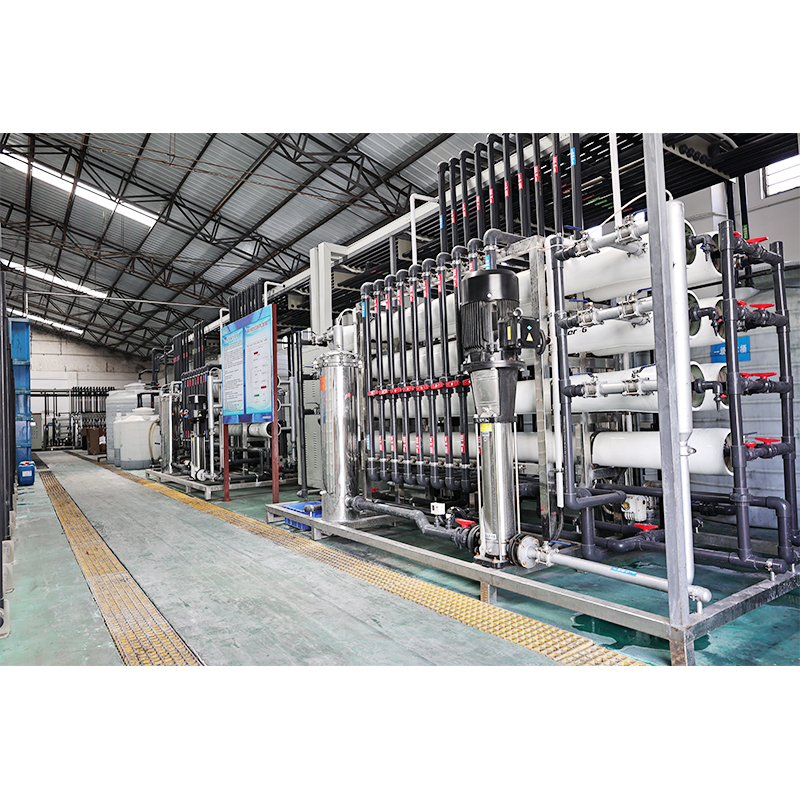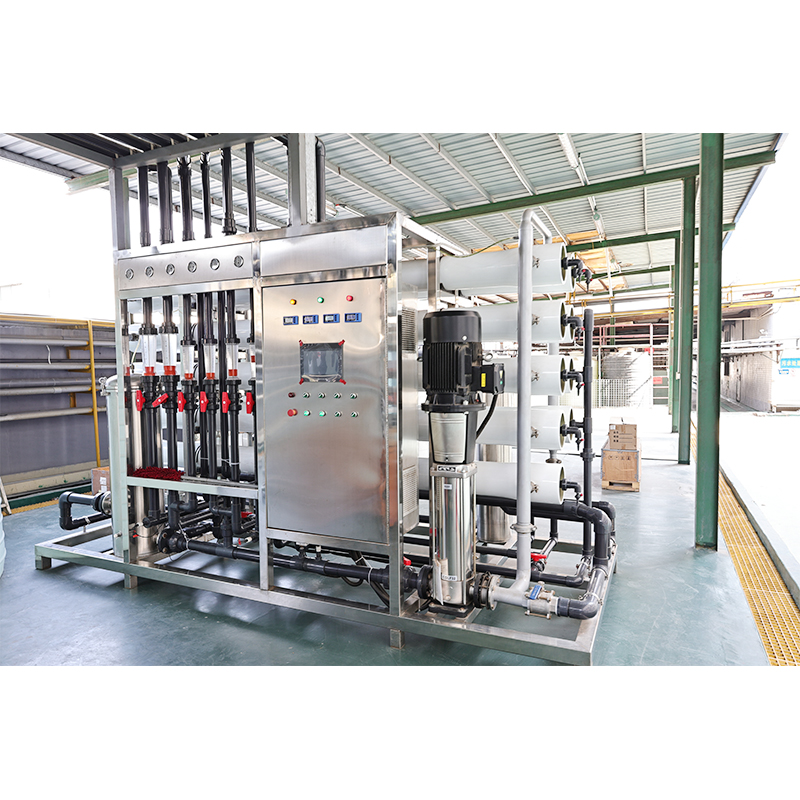How does pH pure water equipment accurately regulate the pH value of its outlet water to maintain a stable pH?
Release Time : 2025-10-27
In industries such as high-end manufacturing, biopharmaceuticals, electronics and semiconductors, precision laboratories, and the food and beverage industry, purified water is not only a fundamental medium in the production process but also a key factor directly impacting product quality and process stability. The pH value of water, as a key indicator of its acid-base balance, must be controlled within an extremely precise range. Excessively high or low pH values can cause equipment corrosion, affect chemical reactions, disrupt the cellular environment, or lead to product batch instability. Therefore, how pH pure water equipment accurately regulates the pH value of its outlet water to maintain a stable pH value is a key measure of its technical level and system reliability.
pH pure water equipment is more than a simple filtration device; it is a closed-loop system that integrates water quality monitoring, intelligent feedback, and precise dosing control. Its core lies in real-time sensing and rapid response to water quality changes. The equipment is equipped with highly sensitive online pH sensors that continuously monitor the acid-base status of the water outlet. These sensors are fast-responding and highly resistant to interference, accurately capturing even subtle pH fluctuations in the water and transmitting the signals in real time to the central control system. The system compares and analyzes the water against pre-set target values. If any deviation is detected, it immediately activates the adjustment mechanism to ensure that water quality remains within the set range.
The adjustment process typically combines micro-dosing with mixing optimization. Based on the water quality requirements, the system automatically injects a very small amount of an acidic or alkaline adjuster, such as food-grade phosphoric acid or sodium hydroxide solution, into the purified water. The dosage is strictly controlled by a precision metering pump, ensuring precise dosing and rapid start and stop times, avoiding overdosing and overcorrection. The agent is fully integrated with the water flow through a dedicated mixing chamber or static mixer, ensuring a uniform reaction with no dead spots. The entire process requires no human intervention and is fully automated, significantly reducing the risk of human error.
Critically, the system features dynamic feedback capabilities. Traditional adjustment methods often rely on open-loop control, i.e., fixed dosages, which are difficult to adapt to fluctuations in water source or load. Advanced pH pure water equipment, however, employs a closed-loop feedback mechanism, continuously monitoring the adjusted outlet pH and dynamically adjusting the next round of dosing parameters based on the actual results. This "test-adjust-retest" cycle enables the system to self-correct, quickly restoring stability and maintaining consistent outflow quality even when influent water quality fluctuates.
The equipment's process design fully considers water flow stability and reaction time. A rational piping layout avoids dead spots and stagnant areas, ensuring the chemical and water react in the fastest possible time. Furthermore, the system can be equipped with a buffer tank or retention chamber to provide ample time for chemical reactions and prevent inadequate adjustment due to excessive flow rates. The entire process is carried out in a sealed environment, preventing carbon dioxide from the air from dissolving into the water and affecting pH, further improving control accuracy.
To meet the needs of different industries, the equipment can also be integrated with multi-stage pretreatment units. Pre-processing with reverse osmosis, ultrafiltration, or ion exchange systems removes impurities, organic matter, and particulates from the water, providing high-purity base water and creating an excellent foundation for pH adjustment. Pure water is less susceptible to external interference, making pH easier to control and the adjustment process smoother, reducing chemical consumption and system burden.
Furthermore, the equipment is constructed of corrosion-resistant materials such as UPVC, PVDF, or 316L stainless steel, ensuring structural integrity and stable operation despite long-term exposure to acidic and alkaline solutions. The user-friendly control system supports remote monitoring and parameter setting, allowing operations and maintenance personnel to monitor operational status in real time and adjust strategies promptly.
In practical applications, this precise and stable pH control capability ensures the yield rate of semiconductor cleaning processes, the bioactivity of pharmaceutical solutions, the accuracy of laboratory analyses, and the consistent taste of high-end beverages.
In summary, the pH Pure Water Equipment achieves precise regulation and long-term stability of effluent pH through high-precision sensing, intelligent feedback control, micro-dosing, and optimized mixing processes. It is not only water treatment equipment but also an indispensable "water quality gatekeeper" in industrial production, safeguarding the purity and balance of every drop of water with the power of technology.
pH pure water equipment is more than a simple filtration device; it is a closed-loop system that integrates water quality monitoring, intelligent feedback, and precise dosing control. Its core lies in real-time sensing and rapid response to water quality changes. The equipment is equipped with highly sensitive online pH sensors that continuously monitor the acid-base status of the water outlet. These sensors are fast-responding and highly resistant to interference, accurately capturing even subtle pH fluctuations in the water and transmitting the signals in real time to the central control system. The system compares and analyzes the water against pre-set target values. If any deviation is detected, it immediately activates the adjustment mechanism to ensure that water quality remains within the set range.
The adjustment process typically combines micro-dosing with mixing optimization. Based on the water quality requirements, the system automatically injects a very small amount of an acidic or alkaline adjuster, such as food-grade phosphoric acid or sodium hydroxide solution, into the purified water. The dosage is strictly controlled by a precision metering pump, ensuring precise dosing and rapid start and stop times, avoiding overdosing and overcorrection. The agent is fully integrated with the water flow through a dedicated mixing chamber or static mixer, ensuring a uniform reaction with no dead spots. The entire process requires no human intervention and is fully automated, significantly reducing the risk of human error.
Critically, the system features dynamic feedback capabilities. Traditional adjustment methods often rely on open-loop control, i.e., fixed dosages, which are difficult to adapt to fluctuations in water source or load. Advanced pH pure water equipment, however, employs a closed-loop feedback mechanism, continuously monitoring the adjusted outlet pH and dynamically adjusting the next round of dosing parameters based on the actual results. This "test-adjust-retest" cycle enables the system to self-correct, quickly restoring stability and maintaining consistent outflow quality even when influent water quality fluctuates.
The equipment's process design fully considers water flow stability and reaction time. A rational piping layout avoids dead spots and stagnant areas, ensuring the chemical and water react in the fastest possible time. Furthermore, the system can be equipped with a buffer tank or retention chamber to provide ample time for chemical reactions and prevent inadequate adjustment due to excessive flow rates. The entire process is carried out in a sealed environment, preventing carbon dioxide from the air from dissolving into the water and affecting pH, further improving control accuracy.
To meet the needs of different industries, the equipment can also be integrated with multi-stage pretreatment units. Pre-processing with reverse osmosis, ultrafiltration, or ion exchange systems removes impurities, organic matter, and particulates from the water, providing high-purity base water and creating an excellent foundation for pH adjustment. Pure water is less susceptible to external interference, making pH easier to control and the adjustment process smoother, reducing chemical consumption and system burden.
Furthermore, the equipment is constructed of corrosion-resistant materials such as UPVC, PVDF, or 316L stainless steel, ensuring structural integrity and stable operation despite long-term exposure to acidic and alkaline solutions. The user-friendly control system supports remote monitoring and parameter setting, allowing operations and maintenance personnel to monitor operational status in real time and adjust strategies promptly.
In practical applications, this precise and stable pH control capability ensures the yield rate of semiconductor cleaning processes, the bioactivity of pharmaceutical solutions, the accuracy of laboratory analyses, and the consistent taste of high-end beverages.
In summary, the pH Pure Water Equipment achieves precise regulation and long-term stability of effluent pH through high-precision sensing, intelligent feedback control, micro-dosing, and optimized mixing processes. It is not only water treatment equipment but also an indispensable "water quality gatekeeper" in industrial production, safeguarding the purity and balance of every drop of water with the power of technology.







